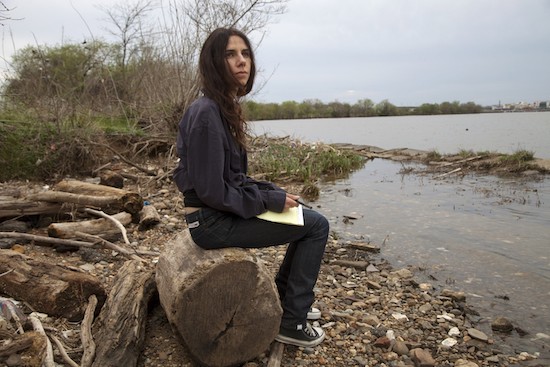One the themes emerging from the majority of films I’ve seen here at the 2019 Berlinale is that of female artists wrestling with their art, gazing into it, and working out what they make and why they make it. It’s in Angela Schanelec’s deliriously strange I Was At Home, But (playing in competition), it’s in Joanna’s Hogg sumptuous quasi-memoir The Souvenir, Kim Longinotto’s intimate portrait of Mafia photographer Letizia Battaglia Shooting The Mafia, Agnès Varda’s wonderful Varda by Agnès and now, Seamus Murphy’s collaboration with PJ Harvey, A Dog Called Money. Aside from the Varda and the Longinotto the other films mentioned consider the privileges the artists have and what they do with that privilege, for this is the age where privilege must be recognised and reckoned with.
Early on in the film, Harvey is exploring a home in Kosovo, the occupants long gone, their lives strewn in and as debris everywhere she steps in her “expensive leather sandals” as the voiceover tells us. She is aware of what amounts to class and cultural tourism but the film mishandles this aspect quite badly and the result is something that in part feels clumsy and awkward, to be kind. Not as a whole, because within this cinematic document to the multi-layered 2016 record, The Hope Six Demolition Projectthere’s much to like and admire. The film tracks Harvey from the gestation of her last, aforementioned, album, following her as she follows the director and longtime collaborator Seamus Murphy on assignments to Kosovo, as mentioned, and also Kabul and Washington DC. She makes notes and observes, and brings back her experiences and proceeds to put them to music in the now infamous purpose built studio at London’s Somerset House where members of the public were invited to observe PJ and her collaborators recording the album in a sound-proofed box behind one-way glass.
Here, in this box of art, the film comes alive. Harvey is relaxed, focused and funny – her impression of Tricky, later to add a verse to a song so Harvey’s doing some filling in, is hilarious and pretty bang on. The film recalls the magic moments of Godard’s One Plus One (Sympathy For The Devil) and Sam Jones’s I Am Trying To Break Your Heart: A Film About Wilco, where the spark that turns a piece of music from an idea into its final, mercurial shape is captured in a thrilling document. It’s not even that cutting between this footage and the trips that formed the lyrical and tonal inspiration for the record is a bad idea. There are some gorgeous travelling sequences and beautifully gentle and contemplative moments observing Harvey in the spaces and places she visits, absorbing it all. What cracks the solid foundations of the film, almost beyond repair, are when it steps outside being a document of artistic process to convey messages to the audience through voiceover and direct to camera address by people she meets along the way that life is hard, difficult, and dangerous for people in these places. It smarts to be told directly by PJ Harvey that the world is shit, in a tone of surprise and authority. It’s genuine, but it’s annoying.
In the Agnès Varda documentary mentioned above and also premiering here at Berlin, Varda by Agnès, the iconic filmmaker says “nothing is trite, if filmed with empathy and love”. Sadly, during parts of A Dog Called Money, Murphy and Harvey test that hypothesis. We don’t need PJ Harvey to tell us the world is shit. We need PJ Harvey to make art that helps us cope with the fact that the world is shit – something, thankfully, she is great at. There are moments, particularly when the film shows how the process of putting a choir on the record comes to fruition is truly special. From a recorded demo played on a smart phone to choir members in a church back office, to the choir belting out the chorus to a packed and dancing church service, to joining harmoniously with Harvey’s fragile power on the final record, it’s thrilling to see the creative process mapped and stretched out like that. It’s also thrilling to surmise how artists like Harvey take the world around them and make art of their experiences. Sadly, seeing so far behind the curtain here has the opposite effect of being revelatory, it is reductive. It feels like a lack of trust that we can join the dots.
After watching the film I walked for a while and took a bus ride to gather my thoughts. I listened to The Hope Six Demolition Project and it’s a hell of a record. Listening to it brought back the moments in the film where Harvey and co are in the box, working it all out, piecing it all together. Arguably it was better having watched the film. These moments of creation were the dominant images floating through my mind and I felt privileged to have been given a sense of how it all happened. Other images forced their way in though, lines of information that I, and I would argue most of PJ’s listeners, already know. I think the more I listen to the record the more those images will fade and the beautifully captured moments of artistic creation will remain. But for now, it feels like a partly successful document of one of Britain’s great contemporary musical artists, and partly a patronising misfire.


